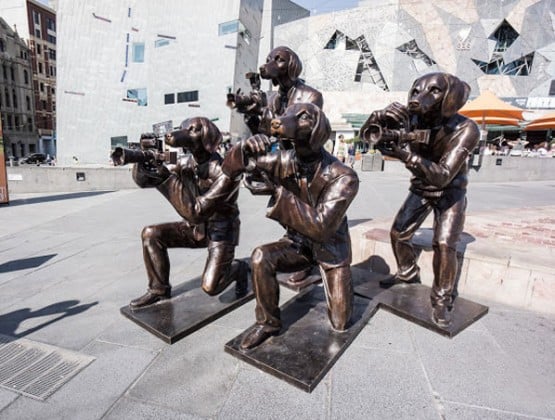Art World
These Artists Want to Save the Rhinos. How? By Building the World’s Biggest Rhino Sculpture
The sculpture depicts all three of the remaining Northern White Rhinos, who live in a preserve in Kenya.

The sculpture depicts all three of the remaining Northern White Rhinos, who live in a preserve in Kenya.

A sculpture coming to New York’s East Village might seem light-hearted, but it actually carries a somber message about the poaching of wild animals. Consisting of three rhinos rendered in bronze and stacked atop on another, The Last Three depicts the last three living Northern White Rhinos, a species bound for extinction.
Australian artists Gillie and Marc Schattner are putting their money where their mouth is, ponying up some $150,000 (Australian) to fabricate the life-size sculpture, which will stand some 16 feet high. Claiming the work will be the world’s largest rhino sculpture, the duo has launched a Kickstarter campaign to raise the final $50,000 necessary to create the piece. (It’s an “all-or nothing” fundraiser, and it may be a stretch; thus far, the appeal has raised just $12,568 US, with $37,255 to go.) A website promoting the project promises that “notable celebrities” will be there to unveil the work, though it doesn’t name them. The site also indicates that the artists will approach heavy hitters like Leonardo DiCaprio and Kate Middleton, both known for their conservationist efforts.
The duo boasts a history of solo exhibitions dating back to 1993, appearing at venues throughout Australia and Asia as well as various iterations of the Affordable Art Fair. They were inspired to create the rhino piece after spending time with the three rhinos this spring at the Ol Pejeta Conservancy, in Kenya. The eldest, a male, has too low a sperm count to reproduce, and the two younger rhinos, both females, are infertile. (The conservancy is, however, hoping to preserve the species through in vitro fertilization and stem cell technology. it aims to raise $1 million to fund the effort.)
Northern White Rhinos have come to such a grim pass because their horns are used in traditional medicine in China and Vietnam. The Schattners have invited the public to write goodbye messages to the rhinos, and are hoping to garner a million of them. They’ll use the messages as a petition to the Chinese and Vietnamese governments to crack down on poaching.

Gillie and Marc Schattner, Paparazzi Dogs, as exhibited at Melbourne’s Fed Square in April 2013.
The stakes are not only high for rhinos, the artists point out, but for the human race as well. “Goodbye rhinos, goodbye planet Earth,” they threaten on the Kickstarter site. According to Conservation magazine, the rhinos do in fact exert an outsize effect on the vital ecology of the savanna, earning the classification of “keystone species.”
Supporters of the project can take home some premiums, such as a foot-tall, limited-edition bronze of the sculpture of the last three rhinos, for $2,500 (Australian); or, for $12,500, a two-foot-high version of the artists’ From Here He Could See the World, which shows a rhino perched atop two stacks of colorful boulders (recalling, curiously enough, those of Ugo Rondinone’s Magic Mountain).
What’s next if the fundraiser is successful? The artists promise they will double down on their commitment, choosing various other cities to host additional iterations of The Last Three. So look out for the bronze rhinos to proliferate even if, tragically, the living ones do not.
The Last Three is expected to be on view at New York’s Astor Place in January, 2018.